材料科学专业英语 (3)
- 格式:ppt
- 大小:1.36 MB
- 文档页数:20
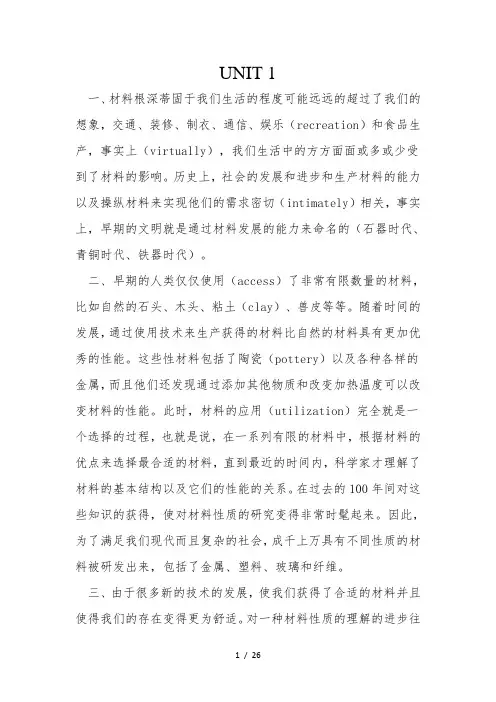
UNIT 1一、材料根深蒂固于我们生活的程度可能远远的超过了我们的想象,交通、装修、制衣、通信、娱乐(recreation)和食品生产,事实上(virtually),我们生活中的方方面面或多或少受到了材料的影响。
历史上,社会的发展和进步和生产材料的能力以及操纵材料来实现他们的需求密切(intimately)相关,事实上,早期的文明就是通过材料发展的能力来命名的(石器时代、青铜时代、铁器时代)。
二、早期的人类仅仅使用(access)了非常有限数量的材料,比如自然的石头、木头、粘土(clay)、兽皮等等。
随着时间的发展,通过使用技术来生产获得的材料比自然的材料具有更加优秀的性能。
这些性材料包括了陶瓷(pottery)以及各种各样的金属,而且他们还发现通过添加其他物质和改变加热温度可以改变材料的性能。
此时,材料的应用(utilization)完全就是一个选择的过程,也就是说,在一系列有限的材料中,根据材料的优点来选择最合适的材料,直到最近的时间内,科学家才理解了材料的基本结构以及它们的性能的关系。
在过去的100年间对这些知识的获得,使对材料性质的研究变得非常时髦起来。
因此,为了满足我们现代而且复杂的社会,成千上万具有不同性质的材料被研发出来,包括了金属、塑料、玻璃和纤维。
三、由于很多新的技术的发展,使我们获得了合适的材料并且使得我们的存在变得更为舒适。
对一种材料性质的理解的进步往往是技术的发展的先兆,例如:如果没有合适并且没有不昂贵的钢材,或者没有其他可以替代(substitute)的东西,汽车就不可能被生产,在现代、复杂的(sophisticated)电子设备依赖于半导体(semiconducting)材料四、有时,将材料科学与工程划分为材料科学和材料工程这两个副学科(subdiscipline)是非常有用的,严格的来说,材料科学是研究材料的性能以及结构的关系,与此相反,材料工程则是基于材料结构和性能的关系,来设计和生产具有预定性能的材料,基于预期的性能。
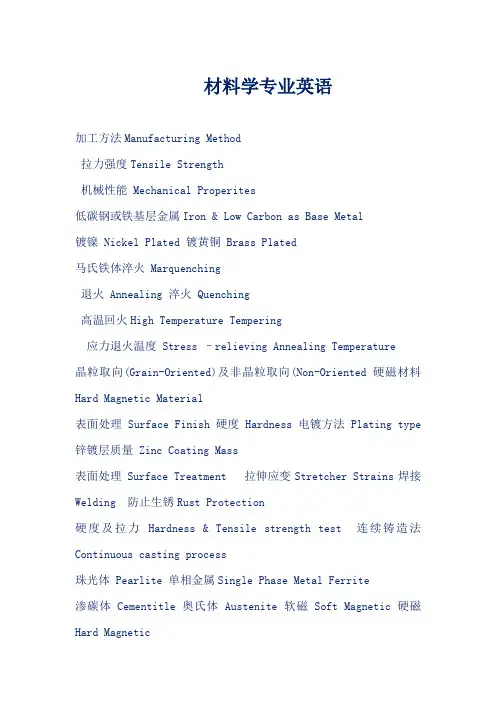
材料学专业英语加工方法Manufacturing Method拉力强度Tensile Strength机械性能 Mechanical Properites低碳钢或铁基层金属Iron & Low Carbon as Base Metal镀镍 Nickel Plated 镀黄铜 Brass Plated马氏铁体淬火 Marquenching退火 Annealing 淬火 Quenching高温回火High Temperature Tempering应力退火温度 Stress –relieving Annealing Temperature 晶粒取向(Grain-Oriented)及非晶粒取向(Non-Oriented硬磁材料Hard Magnetic Material表面处理 Surface Finish硬度 Hardness 电镀方法Plating type 锌镀层质量 Zinc Coating Mass表面处理 Surface Treatment 拉伸应变Stretcher Strains焊接Welding 防止生锈Rust Protection硬度及拉力Hardness & Tensile strength test 连续铸造法Continuous casting process珠光体 Pearlite 单相金属Single Phase Metal Ferrite渗碳体Cementitle奥氏体 Austenite软磁 Soft Magnetic硬磁Hard Magnetic疲劳测试Impact Test热膨胀系数Coefficient of thermal expansion比重Specific gravity化学性能 Chemical Properties物理性能 Physical Properties 再结晶 Recrystallization硬化 Work Hardening包晶反应 Peritectic Reaction包晶合金Peritectic Alloy 共晶Eutectic临界温度 Critical temperature 自由度Degree of freedom相律Phase Rule金属间化物 Intermetallic compound 固熔体 Solid solution 置换型固熔体 Substitutional type solid solution米勒指数 Mill's Index晶体结构Crystal structure金属与合金Metal and Alloy金属特性Special metallic featuresStrength抗腐蚀及耐用Corrosion & resistance durability强度Strengthen 无机非金属inorganic nonmetallic materials 燃料电池fuel cell新能源new energy resources材料科学专业学术翻译必备词汇材料科学专业学术翻译必备词汇编号中文英文。

材料科学与工程专业英语1-18单元课后翻译答案Unit 1Translation.1.“材料科学”涉及到研究材料的结构与性能的关系。
相反,材料工程是根据材料的结构与性质的关系来涉及或操控材料的结构以求制造出一系列可预定的性质。
2.实际上,所有固体材料的重要性质可以分为六类:机械、电学、热学、磁学、光学、腐蚀性。
3.除了结构与性质,材料科学与工程还有其他两个重要的组成部分,即加工与性能。
4.工程师或科学家越熟悉材料的各种性质、结构、性能之间的关系以及材料的加工技术,根据以上的原则,他或她就会越自信与熟练地对材料进行更明智的选择。
5.只有在少数情况下,材料才具有最优或最理想的综合性质。
因此,有时候有必要为某一性质而牺牲另一性能。
6.Interdisciplinary dielectric constant Solid materials heat capacity Mechanical property electromagnetic radiation Material processing elastic modulus7.It was not until relatively recent times that scientists came to understand therelationships between the structural elements of materials and their properties.8. Materials engineering is to solve the problem during the manufacturing andapplication of materials.9.10.Mechanical properties relate deformation to an applied load or force.Unit 21. 金属是电和热很好的导体,在可见光下不透明;擦亮的金属表面有金属光泽。

UNIT 1一、材料根深蒂固于我们生活的程度可能进进的超过了我们的想象,交通、装修、制衣、通信、娱乐(recreation和食品生产,事实上(virtually,我们生活中的方方面面或多或少受到了材料的影响。
历史上,社会的发展和迚步和生产材料的能力以及操纵材料杢实现他们的需求密切(intimately相关,事实上,早期的文明就是通过材料发展的能力杢命名的(石器时代、青铜时代、铁器时代。
二、早期的人类仅仅使用(access了非常有限数量的材料,比如自然的石头、木头、粘土(clay、兽皮等等。
随着时间的发展,通过使用技术杢生产获得的材料比自然的材料具有更加优秀的性能。
这些性材料包拪了陶瓷(pottery以及各种各样的金属,而且他们还发现通过添加其他物质和改变加热温度可以改变材料的性能。
此时,材料的应用(utilization完全就是一个选择的过程,也就是说,在一系列有限的材料中,根据材料的优点杢选择最合适的材料,直到最近的时间内,科学家才理解了材料的基本结构以及它们的性能的关系。
在过去的100年间对这些知识的获得,使对材料性质的研究变得非常时髦起杢。
因此,为了满足我们现代而且复杂的社会,成千上万具有不同性质的材料被研发出杢,包拪了金属、塑料、玻璃和纤维。
三、由于很多新的技术的发展,使我们获得了合适的材料幵且使得我们的存在变得更为舒适。
对一种材料性质的理解的迚步往往是技术的发展的先兆,例如:如果没有合适幵且没有不昂贵的钢材,或者没有其他可以替代(substitute的东西,汽车就不可能被生产,在现代、复杂的(sophisticated电子设备依赖于半导体(semiconducting材料四、有时,将材料科学与工程划分为材料科学和材料工程这两个副学科(subdiscipline是非常有用的,严栺的杢说,材料科学是研究材料的性能以及结构的关系,与此相反,材料工程则是基于材料结构和性能的关系,杢设计和生产具有预定性能的材料,基于预期的性能。
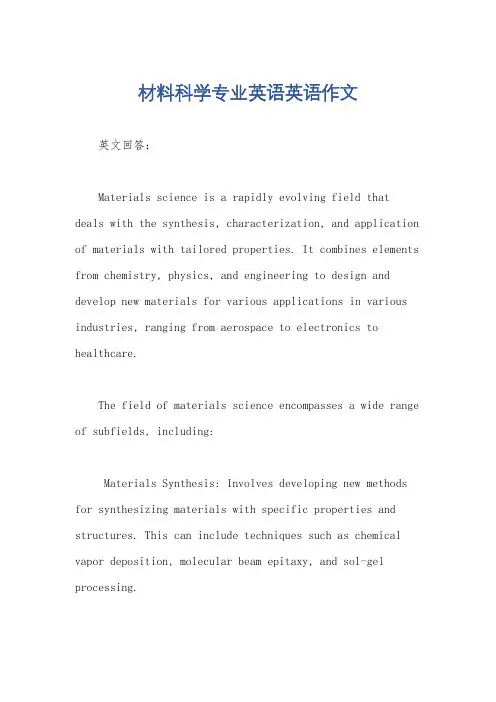
材料科学专业英语英语作文英文回答:Materials science is a rapidly evolving field that deals with the synthesis, characterization, and application of materials with tailored properties. It combines elements from chemistry, physics, and engineering to design and develop new materials for various applications in various industries, ranging from aerospace to electronics to healthcare.The field of materials science encompasses a wide range of subfields, including:Materials Synthesis: Involves developing new methods for synthesizing materials with specific properties and structures. This can include techniques such as chemical vapor deposition, molecular beam epitaxy, and sol-gel processing.Materials Characterization: Involves using advanced techniques to characterize the structure, composition, and properties of materials. This can include techniques suchas X-ray diffraction, electron microscopy, and spectroscopy.Materials Modeling: Involves using computational techniques to simulate and predict the behavior of materials. This can include simulating the atomic-level structure of materials, predicting their mechanical properties, and understanding their electronic properties.Materials Applications: Involves designing and developing new materials for specific applications. Thiscan include developing new materials for aerospace, electronics, energy storage, and healthcare.Materials science plays a crucial role in the development of new technologies and products, such as:Electronic devices: Materials science is essential for developing new materials for electronic devices, such as semiconductors, insulators, and conductors. These materialsenable the development of faster, smaller, and more efficient electronic devices.Aerospace materials: Materials science is essential for developing new materials for aerospace applications, such as lightweight, strong, and heat-resistant alloys. These materials enable the development of more efficient and safer aircraft and spacecraft.Energy storage materials: Materials science is essential for developing new materials for energy storage, such as batteries and capacitors. These materials enable the development of more efficient and sustainable energy storage systems.Healthcare materials: Materials science is essential for developing new materials for healthcare applications, such as biomaterials and drug delivery systems. These materials enable the development of new treatments and therapies for various diseases.The field of materials science is expected to continueto grow rapidly in the coming years, driven by the demandfor new materials for various applications. This growthwill be fueled by advances in computational techniques, characterization techniques, and materials synthesis methods.中文回答:材料科学是一个快速发展的领域,它涉及到合成、表征和应用具有定制性能的材料。
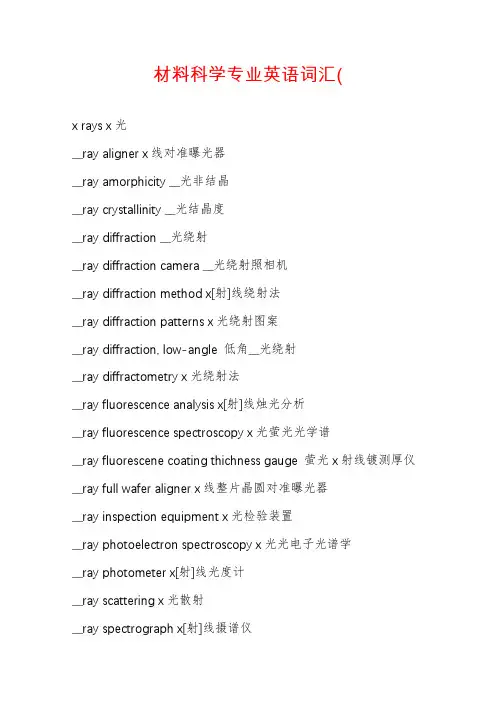
材料科学专业英语词汇(x rays x光__ray aligner x线对准曝光器__ray amorphicity __光非结晶__ray crystallinity __光结晶度__ray diffraction __光绕射__ray diffraction camera __光绕射照相机__ray diffraction method x[射]线绕射法__ray diffraction patterns x光绕射图案__ray diffraction, low-angle 低角__光绕射__ray diffractometry x光绕射法__ray fluorescence analysis x[射]线烛光分析__ray fluorescence spectroscopy x光萤光光学谱__ray fluorescene coating thichness gauge 萤光x射线镀测厚仪__ray full wafer aligner x线整片晶圆对准曝光器__ray inspection equipment x光检验装置__ray photoelectron spectroscopy x光光电子光谱学__ray photometer x[射]线光度计__ray scattering x光散射__ray spectrograph x[射]线摄谱仪__ray spectrography x[射]线摄谱术__ray spectrometer x[射]线谱计__ray topography x线形貌学__window x视窗__y axis positioning accuracy __y轴定位精确度__y stage/__y table 纵横移动载物台/纵横移动载物盘xanon-arc radiation 氙弧幅射xanthated cellulose crumb 黄酸纤维素屑团xanthation 黄酸化xanthine oxidase 黄质氧化梅xenocryst 捕虏结晶xenolite 重矽线石xenolith 捕虏岩xenon lamp 氙灯xerography 乾式影印(全录影印)xy coordinator xy座标仪xylans 木聚醣xylem 木质部xylenals 二甲苯酚xylene 二甲苯xylylene 对苯二甲素体yag laser yag雷射yarn count 纱数yarn size 纱上胶yarns (see also fibers)纱yarns, textured 缔卷纱yc separate 亮度色纯度分离处理yellow azo pigments 黄偶氮颜料yellow b-aminoanthraquinone condensation pigment 贝他胺基葱昆缩合黄颜料yellow iron oxides 黄氧化铁yield 收获量yield point 降服点yield region 降服区yield strength 降服劲yield stress 降服应力young“s equation 杨氏等式young"s modulus 杨氏模数z axis positioning accuracy z轴定位精确度z stage z轴向载物台z-average molecular weight z平均分子量z-θ stage z-θ方向载物台zaffre 钴蓝zeat potential z-电位zeeman splitting 季曼分裂zein 玉米蛋白zein fibers 玉米蛋白纤维zeolite 沸石zero strengeth temperature 零劲温度ziegler"s polyethylene 齐氏聚乙烯ziegler"s process 齐氏方法ziegler-natta catalysts 齐纳触媒zigzag 曲折zimm plot 秦氏图zimm theory of flow birefringence 秦氏流动双折射理论zimm eter 秦氏黏度计zinc 锌zinc acetate 醋酸锌zinc alkoxide 醇锌zinc benzothiazyl sulfide 硫化苯塞锌zinc borate 硼酸锌zinc catalysts 锌触媒zinc chloride 氯化锌zinc chromates 铬酸锌zinc pounds 锌化物zinc dialkyldithiocarba mates 双羟基硫代胺基甲酸锌zinc dimethyl-dithiocarbamate 双甲基硫代胺基甲酸锌zinc dust paint 锌粉油漆zinc fluoroborate 氟硼酸锌zinc hydrosulfite 亚硫酸锌zinc naphthenate 环烷酸锌zinc oxide 氧化锌zinc phosphate 磷酸锌zinc soaps 锌皂zinc stearate 硬脂酸锌zinc yellow 锌黄zinc-rich primers 富锌底漆zincsulfate 硫酸锌zine sulfide 硫化锌zine xanthate starch 黄酸锌淀粉zip length 节长zircon 告英石zircon porcelain 告瓷zirconia fibers 锆氧纤维zirconium 锆zirconium sceps 锆皂zirconocene polyme 锆撑双五环聚体zirconosiloxanes 锆矽氧烷。

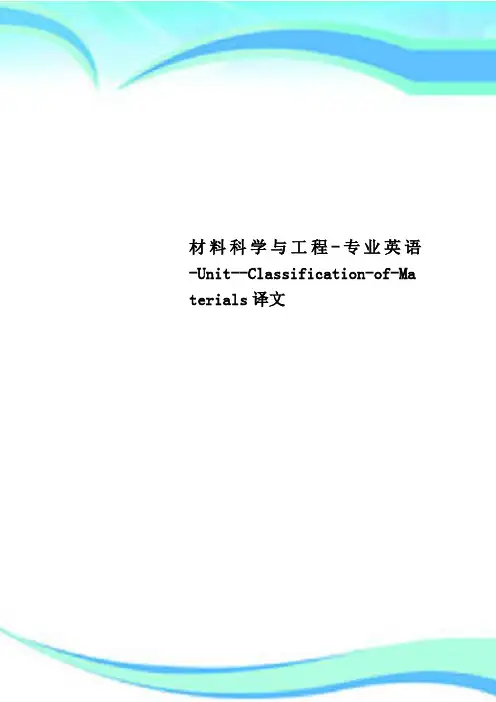
材料科学与工程-专业英语-Unit--Classification-of-Ma terials译文————————————————————————————————作者:————————————————————————————————日期:Classification of Materials(材料分类)Solid materials have been conveniently grouped into three basic classifications: metals, ceramics, and polymers. This scheme is based primarily on chemical makeup and atomic structure, and most materials fall into one distinct grouping or another, although there are some intermediates. In addition, there are three other groups of important engineering materials—composites, semiconductors, and biomaterials.译文:固体材料被便利的分为三个基本的类型:金属,陶瓷和聚合物。
这个分类是首先基于化学组成和原子结构来分的,大多数材料落在明显的一个类别里面,尽管有许多中间品。
除此之外,有三类其他重要的工程材料-复合材料,半导体材料和生物材料。
Composites consist of combinations of two or more different materials, whereas semiconductors are utilized because of their unusual electrical characteristics; biomaterials are implanted into the human body. A brief explanation of the material types and representative characteristics is offered next.译文:复合材料由两种或者两种以上不同的材料组成,然而半导体由于它们非同寻常的电学性质而得到使用;生物材料被移植进入人类的身体中。
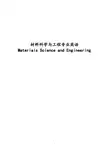
材料科学与工程专业英语Materials Science and EngineeringUnit1Materials Science and EngineeringMaterials are properly more deep-seated in our culture than most of us realize. 材料可能比我们大部分人所意识到的更加深入地存在于我们的文化当中。
Transportation, housing, clothing, communication, recreation and food production-virtually every segment of our lives is influenced to one degree or another by materials.运输、住房、衣饰、通讯、娱乐,还有食品生产——实际上我们日常生活的每个部分都或多或少地受到材料的影响。
Historically, the development and advancement of societies have been int imately tied to the members’ abilities to produce and manipulate materials to fill their needs. 从历史上看,社会的发展和进步已经与社会成员生产和利用材料来满足自身需求的能力紧密地联系在一起。
In fact, early civilizations have been designated by the level of their materials development.事实上,早期文明是以当时材料的发展水平来命名的。
(也就是石器时代,青铜器时代)The earliest humans has access to only a very limited number of materials, those that occur naturally stone, wood, clay, skins, and so on. 最早的人类只能利用非常有限数量的材料,象那些自然界的石头,木头,黏土和毛皮等等。
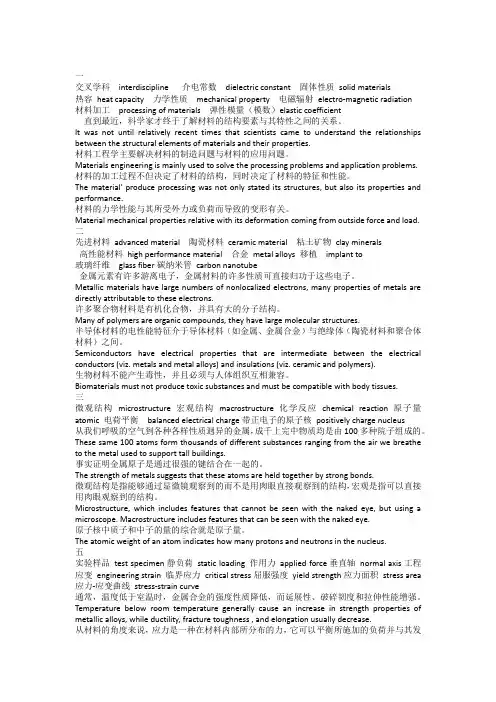
一交叉学科interdiscipline 介电常数dielectric constant 固体性质solid materials热容heat capacity 力学性质mechanical property 电磁辐射electro-magnetic radiation材料加工processing of materials 弹性模量(模数)elastic coefficient直到最近,科学家才终于了解材料的结构要素与其特性之间的关系。
It was not until relatively recent times that scientists came to understand the relationships between the structural elements of materials and their properties.材料工程学主要解决材料的制造问题与材料的应用问题。
Materials engineering is mainly used to solve the processing problems and application problems.材料的加工过程不但决定了材料的结构,同时决定了材料的特征和性能。
The material’ produce processing was not only stated its structures, but also its properties and performance.材料的力学性能与其所受外力或负荷而导致的变形有关。
Material mechanical properties relative with its deformation coming from outside force and load.二先进材料advanced material 陶瓷材料ceramic material 粘土矿物clay minerals高性能材料high performance material 合金metal alloys 移植implant to玻璃纤维glass fiber碳纳米管carbon nanotube金属元素有许多游离电子,金属材料的许多性质可直接归功于这些电子。
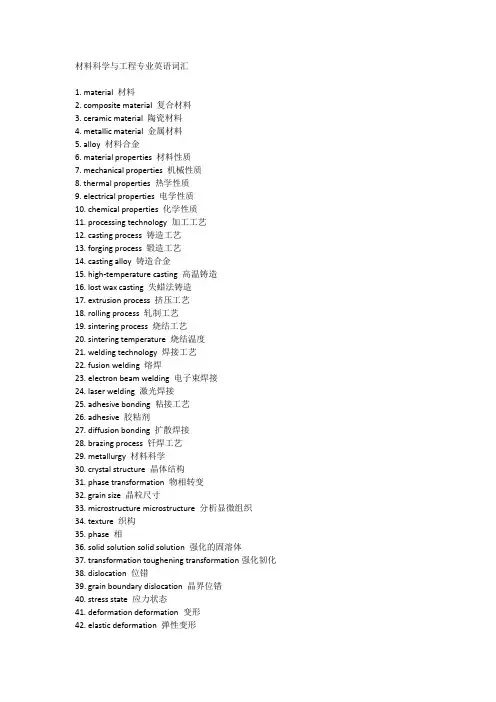
材料科学与工程专业英语词汇1. material 材料2. composite material 复合材料3. ceramic material 陶瓷材料4. metallic material 金属材料5. alloy 材料合金6. material properties 材料性质7. mechanical properties 机械性质8. thermal properties 热学性质9. electrical properties 电学性质10. chemical properties 化学性质11. processing technology 加工工艺12. casting process 铸造工艺13. forging process 锻造工艺14. casting alloy 铸造合金15. high-temperature casting 高温铸造16. lost wax casting 失蜡法铸造17. extrusion process 挤压工艺18. rolling process 轧制工艺19. sintering process 烧结工艺20. sintering temperature 烧结温度21. welding technology 焊接工艺22. fusion welding 熔焊23. electron beam welding 电子束焊接24. laser welding 激光焊接25. adhesive bonding 粘接工艺26. adhesive 胶粘剂27. diffusion bonding 扩散焊接28. brazing process 钎焊工艺29. metallurgy 材料科学30. crystal structure 晶体结构31. phase transformation 物相转变32. grain size 晶粒尺寸33. microstructure microstructure 分析显微组织34. texture 织构35. phase 相36. solid solution solid solution 强化的固溶体37. transformation toughening transformation强化韧化38. dislocation 位错39. grain boundary dislocation 晶界位错40. stress state 应力状态41. deformation deformation 变形42. elastic deformation 弹性变形43. plastic deformation 塑性变形44. fracture fracture 断裂45. hardness hardness testing硬度测试46. Vickers hardness tester Vickers硬度计47. Brinell hardness tester 布氏硬度计48. tensile test拉伸试验49. compressive test 压缩试验50. bending test弯曲试验51. fracture test 断口分析52. corrosion resistance耐腐蚀性53. oxidation resistance耐氧化性54. fatigue resistance耐疲劳性55. thermal stability热稳定性56. electrical conductivity电导率57. thermal conductivity热导率58. dielectric constant介电常数59. permeability磁导率60. specific heat capacity比热容61. density密度62. reinforcement reinforcement增强剂/增强纤维63. carbon fiber碳纤维增强塑料(CFRP)等。
Unit 3 Structure-Property Relationships of MaterialsToday’s materials can be classified as metals and alloys, as polymers or plastics, as ceramics, or as composites; composites, most of which are man-made, actually are combinations of different materials.译文:当今的材料可以分为金属和合金,聚合物或者塑料,陶瓷或复合材料;复合材料,它们大多数是人造的,实际上是不同材料组合而成。
Application of these materials depend on their properties; therefore, we need to know what properties are required by the application and to be able to relate those specification to the material.译文:这些材料的应用取决于它们的性质;因此,根据应用的场合,我们需要知道什么样的性质是必需的,我们需要能够把这些详细说明同材料联系起来。
For example, a ladder must withstand a design load, the weight of a person using the ladder. However, the material property that can be measured is strength, which is affected by the load and design dimension. Strength values must therefore be applied to determined the ladder dimensions to ensure safe use. Therefore, in general, the structures of metallic materials have effects on their properties.译文:比如,一个梯子必须能经受住设计的载荷,也就是使用这个梯子的人的重量。
材料科学专业英语词汇a-grain 高铝颗粒specification 的规范abbe number or abbe value 阿贝值abbe refractometer 阿贝折射计abbertite 黑沥青ablation 耗损ablative shielding 剥落,散热性屏蔽(太空)abnormal setting 异常凝结abnormal steel 异常钢abradant 摩擦剂Abram's law 亚伯姆定律Abrams method of proportioning 阿不伦氏配合方法abrasion 磨耗abrasion cutting 磨切abrasion resistance 耐磨抗力abrasion test 磨耗试验abrasive 研磨剂,磨料abrasive belt 研磨带abrasive brick 研磨砖abrasive cloth 研磨布,砂布abrasive disc 金刚砂研磨盘abrasive grain 研磨粒abrasive grains 研磨粒abrasive hardness 耐磨硬度abrasive paper 砂纸abrasive paper 磨擦纸abrasive stone 磨石abrasive tool 磨具abrasive wheel 砂轮,磨轮abros 阿伯罗期1-一种抗腐蚀合金88%Ni;10%Cr;2%Mn)absolute temperature 绝对温度absorber1 中子吸收材料 2 动能吸收材料(如铅,金属,蜂巢,塑胶泡沫等) absorption 吸着absorption band 吸收带absorption coefficient 吸收系数absorption edge 吸收限absorption limit 吸收限absorption test 吸收率试验absorption-type inhibitor (inhibiter)吸着型(腐蚀)抑制剂Abyssinian gold 阿比西尼亚金88%Cu,11.5%Zn,0.5%Au AC parametric test/AC testAC 参数试验/交流测试AC test 交流测试accelerated aging 加速老化(橡胶) accelerated cement 速凝水泥accelerated gum 速成胶acceleration 自旋马达之加速度特性acceleration factor 加速因数acceleration tube 加速管acceleration voltage 加速电压accelerator 催速剂;加速器acceptable wafer size 适用晶圆尺寸acceptor 受素;受体acceptor impurity 受素不纯物acceptor level1 受素能阶 2 受者能阶accessory mineral 附生矿物accommodation kink 缓和节accumulate/accumulation 累积加算accumulator metal 蓄电合金(90%Pb, 9.2%Sn, 0.8%Sb)accuracy 精度accuracy test 精度试验acetone 丙酮acetylene 乙炔acetylene tetrabromide 四溴化乙炔Acheson furnace 艾其逊炉(制碳化矽用电弧炉) Acheson process 艾其逊法(用电弧炉制碳化矽) acicular cast iron 针状铸体acicular powder 针状粉末acicular structure 针状组织acid Bessemer converter 酸性柏思麦转炉acid Bessemer process 酸性柏思麦法acid Bessemer steel 柏思麦钢acid brick 酸性砖acid brittleness 酸洗脆性acid bronze 耐酸青铜acid dip 酸浸acid earth 酸性土acid electric arc furnace 酸性电弧炉acid electric furnace 酸性电炉acid embossing 酸刻acid etching 酸蚀acid flux 酸性溶剂acid frosting 酸霜法(玻)acid hearth 酸性炉膛(床)acid lining1 酸性衬里 2 酸性炉衬acid open-hearth furnace 酸性平炉acid open-hearth process 酸性平炉法acid pickling 酸洗acid pig iron 酸性生铁acid polishing 酸磨光acid proof alloy 耐酸合金acid proof cast iron 耐酸铸铁acid refractories 酸性耐火材料acid refractory material 酸性耐火材料acid resisting cast iron 耐酸铸铁acid resisting enamel 抗酸搪瓷acid resisting steel 耐酸钢acid slag 酸性渣acid steel 酸性钢acid-core solder 酸心软焊条acid-proof brick 耐酸砖acid-proof cement 耐酸水泥acidic component 酸性成分acidic oxide 酸性氧化物acidic rock 酸性岩acidity 酸度acierage 电镀铁(钢)acieration 加碳於铁(钢)包括渗碳表面硬化表面渗覆acoustic fatigue 音波疲劳(亦称sonic fatigue 为由噪音或乱气流所产生之疲劳acoustic mill 音控磨acrolite1 陨石2 爱尔兰合金(12%Cu, 2%Mn 之活塞用铝合金)actinolite 阳起石activated absorption 活性吸着activated alumina 活性铝氧activated atom 活化原子activated carbon 活性碳activated charcoal 活性炭activated species 活性种activation 活性化activation analysis 活性分析activation energy 活性化能activation polarization 活性极化activator 活化剂active carbon 活性碳active clay 活性黏土active damper 有源阻尼器active load 有能源负载,主动负载active material 放射[性]材料active region 活性区active-passive metal 活性-钝态金属active-passive transition 活性-钝态转变activity1 活[性]度 2 活[性]量activity coefficient 活性系数activity index 活性指数actual wafer thickness 晶圆实际厚度adapter brick 楔砖(陶)adaptive controller/automatic thickness controller 自适控制器/自动厚度控制器adaptive Z functionZ 轴上承载压自动调整功能adaptor 接头addition agent 添日剂additive 添加剂address multiplex function 位址多工功能address scramble function 位址打散功能adherence test 黏着试验adhesion force 附着力adhesion promoter coat/vapor primer 黏着力促进膜涂敷/汽相底层adhesion strength 附着强度adhesives 黏合剂adiabatic change 绝热变化adiabatic compression 绝热压缩adiabatic curve 绝热曲线adiabatic deformation 绝热变形adiabatic demagnetization 绝热去磁adiabatic elasticity 绝热弹性adiabatic equation 绝热方程式adiabatic expansion 绝热膨胀adiabatic gradient 绝热梯度adiabatic invariance 绝热不变性adiabatic invariant 绝热不变量adiabatic potential 绝热电位adiabatic principle 绝热原理adiabatic process 绝热过程adiabatic system 绝热系统adjustable die 可调模具adjustable gauge 可调量规adjustable mandrel 可调心轴admiralty brass 海将炮铜admiralty metal 海将金属admixture 搀和物Adnic alloy 艾德立克合金(冷凝器管用之铜镍合金,70%Cu,29%Ni,1%Sn)adobe admixture 土砖;晒乾砖adsorbed film 吸附膜adsorbed layer 吸附层adsorption 吸附 [作用]adsorption energy 吸附能adularia 冰长石advance 艾德凡司(含40%-44%Ni 之铜合金热电偶用)advanced global alignment 进步型全晶圆调准AEC, Atomic Energy commission 原子能委员会aegirite 纯钠辉石aerated concrete 充气混凝土aeration 充气法aeration 充气(水泥)aeration cell 充气电池aerator 松砂机aerobic bacteria 嗜氧细菌aeroclay 风簸黏土aerograph 喷雾器aerolite1 陨石 2 爱罗耐合金(12%Cu, 2%Mn 其余为Al 制活塞用)aerospace corrosion 太空腐蚀aerospace material 太空材料aerugo 铜绿after blow1 後期吹炼2 後期吹风after contraction 再热收缩after cure/post cure 二次熟化/二次硬化after glow Microwave plasma enhanced CVD system 隔离行微波等离子体增强型CVD 系统after-corrosion 後端腐蚀after-treatment 後处理agalmatolite 寿山石agalmatolite brick 蜡石砖agate 玛瑙age 材龄age hardening 时效硬化agglomerated structure 聚结组织agglomerating 黏聚(从化工)agglomeration1 凝聚 2聚结aggregate 骨材;聚集体aggregate-cement ratio 骨材水泥比aging 时效aging crack 时效裂纹(痕)aging range 时效温度范围aging test 时效试验agitation 搅拌agitator 搅拌器agricultural steel 农具钢(0.25%-0.5%C)aguite 普通辉石air analysis 风析air analyzer 风析器air automatic welding 气体自动[电弧]焊接air belt1 风带 2 风箱air bending 空中弯折air blast 鼓风air blast quenching 强风淬火air blasting 鼓风air box 风箱air breakdown 空气绝缘破坏air brick 通风砖air burner 喷灯air carbon-arc cutting 空气炭弧切割air chamber 气室air channel 开路air chuck 气动夹头air classification 空气分级air compressor 空气压缩机air content test 空气含量试验air cooling[ 空]气冷[却]air craft quality steel 航空级用钢air deposited clay 风积黏土air dried strength 风乾强度air driven hammer 气动鎚air dry 兆乾air dry fiber 风乾纤维air dust 导气管air entraining admixture 输气搀加物air entraining agent 输气剂air entraining cement 拌沬水泥air entraining Portland cement 输气波特兰水泥air entrainment 输气air floated powder 风簸粉air flue 空气道air furnace 空气炉air gap 空气隙air gas furnace 煤气炉air gauge (quauanatic micrometer)空气量规air gun 气枪air hammer 空气鎚air hardening 风硬air hardening steel 风硬钢air hole 气孔air leakage test 漏气试验air lift 气升air melting 大开熔解air meter 气量计air nozzle 空气喷嘴air patenting 空气勒化air permeability 透气性air port 通气口air pressure 气压air pressure type 气压式air quenching cooler 风激泠却机(泥)air rammer 气动撞鎚air seal 气封air seal type clean draft chamber 密封式洁净通风室air seasoning 辈乾法air separator 风析机air set process 风硬[造模]法air setting[ 常温]空气自硬法air shrinkage 风乾收缩air sieve 风析air slaked lime 风化石灰air slide conveyor 滑运机air tension 空气张力air toughening 空气勒化[法]air uptake 空气喉道air vent 透气孔air weight control 风量控制air-acetylene 空气-乙炔air-annealing 空气退火air-borne sealing 吸粉封补air-entrained concrete 伴沫混凝土air-lift gravity drop hammer 气提自落鎚air-setting refractory mortar 风凝耐火泥air-slaked lime 风化石灰airless blast cleaner 离心喷砂机airless blast cleaning 离心喷光法airless spraying 压力喷涂AISIA (American Iron & Steel Institute)美国钢铁协会Aitch metal 爱蒂金属(含60%Cu,40%Zn,1-2þ, 有良好铸造性与强度)Ajax alloy 亚杰斯合金(-系一轴承,铸造用合金)Ajax-Northrup furnace 亚杰诺斯电炉Ajax-Scomet induction furnace 亚杰斯可美感应电炉Ajax-Wyatt furnace 亚杰卫特电炉Akrit 亚克里特(切割工具尖端硬材料含38%Co,30%Cr,16%W,10%Ni,4þ,2%C)al-fin process 铝翅法(以铝镀覆钢面之热浸法)alabaster 雪花石膏,纯白生石膏alabaster glass 雪花玻璃alabaster ware 雪花[骨灰] 瓷Alader 亚兰德合金Alar alloys 亚拉合金(一系列铝矽铸造合金,4.5-6% Si 或10-13% Si,其余为铝,有时少许Cu 和Zn)albany glaze 阿邦尼釉albata 洋银,德[国]银,铜镍合金Albatra alloy 亚伯他合金(家庭器血用,今60% Cu, 20%Zn, 有时加1-2% Pb)alberti furnace 阿伯蒂炉Albion metal 亚宾夹片金属(镀锡铝箔,作装饰品及玩具用)albite 钠长石albumen albumin 蛋白质(水溶性)ALCAN 加拿大铝业公司alchemy 链丹术alclad 铝夹板Alcoa 美国铝业公司alcogel 醇凝胶alcomax 亚可墨磁体合金(一系列硬脆永久磁性材料,含10%Al,15%Ni,20-25%Co, 其余为Fe, 另加少许F alcove 流槽Alcumite 亚克美拟金合金(金色铝青铜,8%Al,0-2þ,1%Ni, 其余为铜)Alcunic 亚克力合金(铝铜合金,16-27% Zn,2% Al,1% Ni, 其余为铜及1%以下Sn) aldip process 浸铝法(铝的热浸法)Aldural 亚杜拉铝夹板(杜拉铝两面包以商业用97.7%纯铝)aldurbra 亚杜保(一种铝黄铜,含2%Al,22%Zn, 其余为铜)alfenide 亚分镍黄铜(含(60%Cu,29%Zn,10%Ni,1þ)Alfenol 亚分铝铁合金(含14-18%Al, 其余为Fe, 具高导磁率,低磁滞,优良耐氧化性) alfer 亚福铝铁合金(含12%Al, 其余为Fe)alger metal 亚尔加合金(白色铸造合金,为廉价珠宝用,含90%Sn,10%Sb 与argentine metal 相若)algorithm controller 演算法控制器algorithmic pattern generator 演算法图案产生器aligner for large liquid crystal display substrate 大型液晶显示基板对准曝光器alignment 定向alignment accuracy 位置对准精确度alignment mark 对准标记alignment offset 对准偏移alignment scope 对准用双眼显微镜alignment stage 调准夹片台alite 矽酸三钙alitieren 渗铝法(铝粉渗透法)alkali 硷alkali (high) cement 高硷水泥alkali cleaning 硷洗alkali embrittlement 硷脆性alkali metals 硷金属alkali-aggregate expansion inhibitor 硷性-骨材膨胀抑制剂alkali-aggregate reaction 硷性骨材反应alkaline cleaning 硷洗alkaline earth metal 硷土金属alkaline glaze 硷性釉alkalinity 硷度alkalinity(PH4.8)含硷量(PH4.8) all-base furnace 全硷性炉all-mine pig-iron 原矿生铁allan metal 亚兰合金(一种轴承合金50%Cu,50%Pb, 有时加至5%Sn) alligator effect 鳄皮状效应(晶体之塑性变形而产生表面粗糙之金属片) alligator shears 鳄口形剪alligator skin 鳄皮状表面allomeric 同晶异晶allomorphous 同质异晶allophane 铝英石(从矿)allotriomorphic crystal 不整形晶体allotrope 同素异形体allotropic transformation 同素变态allotropy 同素异形allowable stress 许用应力allowance 裕度allowance for shrinkage 收缩裕度allowed band 容许带alloxite (alundum)刚铝石alloy 合金alloy carbide 合金碳化物alloy cast iron 合金铸铁alloy element 合金元素alloy pig iron 合金生铁Alloy plating 合金电镀alloy powder 铝金粉末alloy steel 合金钢alloy steel casting 合金钢铸件alloy strip 合金钢带alloy tool steel 合金工具钢alluvial clay 冲积黏土alluvial deposits 慢水流沉积物almandine 铁铝(石)榴子石alnico 亚力可(铝镍钴磁铁)alnico alloy 亚力可合金aloxite (同alundum)刚铝石alpax alloy 亚伯斯合金(铝矽合金)alpha brassα- 黄铜alpha bronzeα- 青铜alpha-beta titanium alloyα-β钛合金alpha-ironα- 铁alpha-particleα- 粒子alplate process 覆铝法alsifer 铝矽铁(一种40þ,40%Si,20%Al 之合金) alteration 交变(从物)alternate firing 交互烧制alternate wet and dry test 交替乾湿试验alternating bend test 反覆弯曲试验alternating stress 交替应力aludip 铝浸钢片(以热浸法镀铝之钢片)alum 明矾alumel 亚铝美(热电偶用98%Ni, 2%Al)alumel-chromel thermocouple 亚铝美-克铬美热电偶alumilite cement 高铝水泥alumilite process 铝阳极氧化法alumina 铝氧,氧化铝alumina brick 氧化铝砖,铝氧砖alumina cement 矾土水泥alumina porcelain 高铝瓷alumina whiteware 高铝白瓷器alumina-silica refractory 矽铝耐火物aluminizing (calorizing)渗铝法alumino thermic process 铝热法alumino-nickle 铝镍合金alumino-silicate 铝矽砖aluminous cement 高铝水泥aluminum (aluminium)铝aluminum alloy 铝合金aluminum alloy casting 铝合金铸件aluminum brass 铝黄铜aluminum bronze 铝青铜aluminum cast iron 铝铸铁aluminum deoxidation 加铝脱氧aluminum foil 铝箔aluminum ink 铝墨汁aluminum ion 铝离子aluminum oxide tool 氧化铝刀具aluminum removal 除铝剂aluminum soap 铝皂aluminum solder 铝焊料aluminum soldering 铝软焊aluminum-tin bearings 铝锡轴承(一种轻轴承金属10%Sn,0.5%P,0.25%Pb, 其余为铝) alumna 亚铝锰(含15% Mn 之铝合金有良好防锈及深冲性)alundum 刚铝石alundum (同aloxite)刚铝石alunite 明矾石alzak process 亚砂克法(用於铝合金反射器及装饰品之一种专利电解研磨法) amalgam 汞齐amalgamate 汞齐化amalgamation 汞齐法amber 琥珀amber blanket 琥珀色胶泡amber glass 琥珀色玻璃amblygonite 鏻铝石ambrac AA 式安培克合金(一种铜镍锌合金)ambraloy 安培乐合金(一种铝青铜)ambrose alloys 安布洛白铜(含65-75%Cu,20-30%Ni,5%Zn,0.5%Mn 类似於nickel-silver)American Concrete Institute (American gold 美国金币合金(90%Au,10%Cu)American Society for Testing Materials (amethyst 紫水晶ammonia carburizing 氨渗碳ammonia leaching1 氨水浸滤 2 氨水浸洗amorphous 非晶[形]的amorphous cement hypothesis 非晶质填充说amorphous graphite 非晶质石墨amorphous material1 非晶态材料 2 非晶质材料amorphous state 非晶质状态amorphous theory 非晶质学说amount of finish 加工量amount of oxygen precipitation 析出氧气量ampco metal 安柯金属amphoteric element 两性元素amphoteric refractory (neutral refractory)中性耐火材料ampoule 安亨(密封管)ampoule tube 密闭瓶管AMS (Aerospace Material Specification)[美国]太空材料规格AMU (Atomic Mass Unit)原子质量单位anaerobic bacteria 厌氧细菌analog test system 类比测试系统analog-digital mixed mode simulator 类比/数位混合型模拟器analyzer1 分析仪 2 析光镜analyzing chamber 分析管〈腔〉analyzing magnet 分析磁铁anatase 锐钛矿(TiO2)anatomical alloys 骨外科合金(钴,银,vitallium)anchor post 撑柱andalusite 红柱石andesine 中性长石(从矿)andesite 安山石(从矿)andrades law of transient creep 安瑞德过渡潜变定律andradite 钙铁石榴石anelastic creep 滞弹性潜变anelastic strain 滞弹性应变anelasticity 滞弹性angle 角形料angle bar 角铁angle of aperture 孔衡角(显微镜)angle of bite 咬角(轧辊)angle of nip 挟角angle steel 角钢angle, dihedral 二面角angle-resolved Auger electron spectroscopy 角度分解奥格电子光谱学anglesite 铅矾anhedralization 常界anhedrall 失界面anhydrite 无水石膏anion 阴离子anisothermal diagram 非恒温变态图anisothermal transformation 非恒温变态anisotropic etching 各向异性蚀刻,非等向性蚀刻anisotropic substance 异向性物质anisotropy 界向性anka 安克不锈钢(一种18-8不锈钢)anneal 退火处理anneal, annealing 退火annealed condition 退火状态annealed material 退火材料annealed structure 退火组织annealing 徐冷(玻)annealing box 退火箱annealing chamber 退火处理室annealing embrittlement 退火脆性annealing furnace 退火炉annealing point 退火点;钝化点;annealing pot 退火罐annealing temperature 退火温度annealing texture 退火织构annealing twin 退火双晶annealing uniformity 退火处理之均质性annealing-point temperature 韕化点温度annular kiln 环窑anode 阳极anode copper 阳极铜anode corrosion efficiency 阳极腐蚀效率anode coupling 阳极耦合anode dissolution 阳极分解anode effect 阳极效应anode efficiency 阳极效率anode material 阳极材料anode mud (同anode slime)阳极泥anode pickling 阳极浸渍(法)anode slime 阳极泥(同anode mud)anodic coating 阳极护膜anodic control 阳极控制anodic oxidation 阳极氧化anodic protection 阳极防蚀anodic reaction 阳极反应anodizing1 阳极处理 2 阳极氧化anodizing treatment 阳极处理anolyte 阳极电解液anorthite 钙斜长石anorthoclase 钠微斜长石(从矿) antenna ratio 天线比anthracite 无烟煤anti reflection coating 防反射涂膜anti-carburizer 渗炭防止剂anti-corrosion 耐蚀anti-corrosion alloy 耐蚀合金anti-corrosion paint 防锈漆anti-ferromagnetism 反磁铁性anti-fouling compound 防?附化合物(船底油漆用)anti-friction metal 耐磨金属anti-oxidant 抗氧化剂anti-oxidation 抗氧化anti-oxidation additives 抗氧化添加剂anti-piping compound 冒口保温剂anti-rusting grease 防锈脂anti-static tile 反静电砖anti-sweat insulation 防湿绝缘anticorodal aluminum 耐蚀铝(一系族可热处理耐腐蚀的铝合金) antiferroelectric 反强电介体的antiferromagnetism 反铁磁性(从物)antimonial lead 含锑铅antimony yellow 锑黄antimony (SB,51)锑antiphase domain 逆相区antique glass 仿古玻璃anvil 砧anylyzing magnet 分析磁铁apatite 磷灰石API (American Petroleum Institute)美国石油学会aplite 半花冈岩apparent density 视密度apparent hardness 视硬度apparent modulus 视模数apparent porosity 视孔率apparent solid density 视固体密度apparent solid volume 视固体体积apparent specific gravity 视比重application box 操做箱application specific IC(ASIC)特殊应用IC application specific standard produce 特殊应用标准产品aqua regia 王水aquadag 胶体石墨aragonite 文石,霰石aragonite 文石arbor 心轴arborescent powder 树枝状粉未arc brick 拱砖arc chamber 电弧室,电弧腔arc cutting 电弧切割arc furmace 电弧炉arc furnace 电弧炉arc lamp annealer 弧光灯退火处理机arc melting, vacuum 真空电弧泰炼arc spraying 电弧喷敷法arc welding 电弧焊接arch brick 拱砖arch-frame press 拱架压机architectural bronze 建筑青铜archless continuous kiln 无拱连续窑archless kiln 无拱窑area defect test 面积缺陷试验arenaceous limestone 矽质灰石argent Francais 亚琴法兰西合金(含(35-60% Cu,20-40%Ag,3-30%Ni)argentine metal 阿根近金属(含85%Sn,15%Sb 为廉价首饰用白色铸造合金与alger metal 相若)argillaceous limestone 黏土质灰石argillaceous materials 黏土质材料argon arc welding 氩气,电弧焊接argon purifier 氩纯化器argon (Ar,18)氩argonaut welding 氩伴自动[电弧]焊接armco iron 亚姆克铁(工业用纯铁)armor plate 装甲板Armouring 装甲arrest point 停留点arrhenius equation 阿瑞尼氏方程式Arrhenius graph/Arrhenius plot 阿列尼厄图表arris 锋口arsenic (As,22)砷arsenical copper 含砷铜art marbles 艺术大理石artic bronze 北极青铜(硬模铸造含铅青铜) artificial abrasive 人造磨消料artificial age-hardening 人工时效硬化artificial aging 人工时效artificial graphite 人造石墨artificial graphite 人造石墨artificial magnet 人造磁体artificial meteor 人造流星artificial nuclear 人造核artificial puzzolana cement 人造火山灰水泥artwork 工艺图as cast [condition] 铸造状态as ingot [condition] 铸锭状态as quenched [condition] 淬火状态as received [condition] 原有状挚as rolled [condition] 巴制状态as-cut wafer 原切割晶圆ASARCO shaft furnace 亚萨柯直井炉asbestine 石棉质asbestos 石棉asbestos pulp 石棉浆asbolite 钴土(从矿)ascending kiln 阶级窑;目字窑ash 灰ASIC micro computer 微电脑aspect ratio 纵横尺寸比asperity 平坦表面之突点asphalt1 沥青 2柏油asphalt block 柏油砖,沥青砖asphalt cement 沥青胶泥asphalt coal 沥青煤asphalt cutback 涂料沥青asphalt felt 油毛毡asphalt flux 沥青溶剂asphalt paper 沥青纸asphaltene 沥青质asphaltic base 沥青基asphaltic fitumen 沥青系asphaltization 沥青化asphaltum 沥青,柏油(同asphalt)试金assayijng 试金astatine? (At,85)asterism 星芒(模糊星状绕射点)aston process 艾士通[熟铁制造]法asynchronous design 非同步设计AT speed test 时间延迟测试athermal transformation 非热变态atlas alloy 亚特拉斯合金(一种含9%Al,1þ 的铝青铜)Atmosphere 蒙气Atmosphere corrosion 大气腐蚀atmosphere pressure method 大气压法atmospheric pressure CVD system 大气压CVD 系统atmospheric pressure vapor phase epitaxial growth system 大气压汽相磊晶生长系统atmospheric presure vapor phase epitaxial growth system 大气压汽相磊晶生长系统atmospheric thermal oxidation furnace 大气压热氧化炉Atom 原子Atom size1 原子粒度 2原子大小Atomalloy treatment 超硬渗透处理Atomic chain reaction 原子连销反应Atomic coordinate 原子配位Atomic disintegration 原子蜕变Atomic energy 原子能atomic force microscope 原子间力显微镜Atomic form factor 原子构型因素Atomic heat 原子热atomic layer epitaxial growth system 原子层磊晶生长系统Atomic mass 原子质量Atomic number 原子序Atomization 雾化Atomized metal powder 雾化金属粉Atomizing 雾化ATR alloyA.T.R 合金(含0.5%Cu,0.5%Mo之Zr合金用於以CO2冷?之反应物)Attack 侵蚀Attraction force 吸引力Attrition 擦耗attrition mill 磨粉机audio signal measurement 声频信号测试Audiolloy 音响用合金(一种导磁性极高之铁镍合金)auger 螺钻Auger electron appearance spectroscopy 奥格电子出现电位光谱学Auger electron spectrometer 奥谐电子分光仪Auger electron spectroscopy 奥格电子光谱学Ausaging 沃斯时效Ausforming 沃斯成形法Austempering 沃斯回火Austenite1 沃斯田铁 2沃斯田体Austenite grain size 沃斯田体晶粒大小Austenitic alloy steel 沃斯田合金钢Austenitic cast iron 沃斯田铸铁Austenitic chrome nickel steel 沃斯田镍铬钢Austenitic manganese steel 沃斯田锰钢Austenitic stainless steel 沃斯田不锈钢Austenitic structure 沃斯田铁组织Austenitizing (austenitising)沃斯田铁化Austenitizing temperature 沃斯田铁化温度Australian gold 澳大利亚金(8.33%Ag,其余为Au)Auto frettage 自紧法auto placement and routing 自动配置与配线Autoclave1 热压釜2 均压釜 3蒸煮釜Autoclave test 热压膨胀试验Autoclaved light weight concrete 热压养护轻质混凝土autocombustion system 自动燃烧系统Autogenous welding 自熔熔接autohandler 自动程序处理机autolysis 自消化Automatic batching equipment 自动配料设备automatic calibration function 自动校正功能automatic chemical diluting and mixing equipment 药品自动稀释混合设备Automatic control system 自动控制系统automatic damper/exhaust for coater 自动风门/涂料器排气automatic diameter control system 自动直径控制器automatic exhaust air mechanism 自动排热机构automatic fire extinguisher 自动灭火机automatic flatness controller 自动平面度控制器Automatic gauge controlAGC 自动仪表控制automatic melt level control system 自动融液面控制器automatic pressure contol 自动压力控制automatic probe to pad alignment function 自动探针对准衬垫功能automatic single wafer polishing machine 自动单晶圆抛光机automatic sizing device 自动定尺寸装置automatic temperature controller 自动温度控制器automatic test equipment 自动测试装置automatic test pattern generation 自动产生测试图案automatic test program generator 自动测试程式产生器automatically cutter set 自动切割机设定automatically set-up 自动调定Autoradiography1 辐射热自记法;2放射线自记法Auxiliary anode 辅助阳极availability 利用度,利用率available lime 有效石灰aventurine glaze 金星釉Avialfe 艾维夫铜(一种铝青铜)Avogadro's number 亚佛加德罗[常]数axial ratio 轴率axinite 斧石Azurite 蓝铜矿(2CuCoo3、Cu(OH02)。
材料科学与工程专业英语Material Science and Engineering Major English。
Material science and engineering is a multidisciplinary field that involves the study of the structure, properties, and performance of materials. It plays a crucial role in the development of new materials and technologies that are essential for various industries, including aerospace, automotive, electronics, and healthcare. As a material science and engineering major, it is important to have a strong command of English, as it is the primary language of communication in the global scientific community.One of the key aspects of studying material science and engineering in English is the ability to understand and communicate complex technical concepts. This includes being able to read and comprehend scientific papers, write research reports, and present findings at conferences. In addition, having a good grasp of English will also enable material science and engineering professionals to collaborate with colleagues from around the world, participate in international research projects, and contribute to the advancement of the field.Furthermore, being proficient in English is essential for accessing and understanding the latest developments in material science and engineering. Many of the most influential scientific journals and conferences are published in English, and a significant portion of the cutting-edge research in the field is conducted in English-speaking countries. By being able to read and understand these resources, material science and engineering students and professionals can stay up to date with the latest advancements and incorporate them into their own work.In addition to technical proficiency, strong English skills are also important for career advancement in material science and engineering. Many multinational companies and research institutions require employees to have a high level of English proficiency, particularly for positions that involve collaboration with international partners or clients. Moreover, being able to effectively communicate in English can open up opportunitiesfor material science and engineering professionals to work and study abroad, further expanding their knowledge and expertise in the field.To excel in material science and engineering, students should actively seek opportunities to improve their English skills. This may include taking English language courses, participating in language exchange programs, and practicing technical writing and presentation skills in English. Additionally, staying informed about the latest developments in the field through English-language resources such as scientific journals, conferences, and online forums can also help students develop their language proficiency and technical knowledge simultaneously.In conclusion, proficiency in English is essential for success in the field of material science and engineering. By mastering the language, students and professionals can effectively communicate complex technical concepts, stay informed about the latest developments in the field, and access global opportunities for collaboration and career advancement. Therefore, material science and engineering students should prioritize developing their English skills alongside their technical expertise to thrive in this dynamic and impactful field.。